2014 NISSAN GT-R warning light
[x] Cancel search: warning lightPage 90 of 354
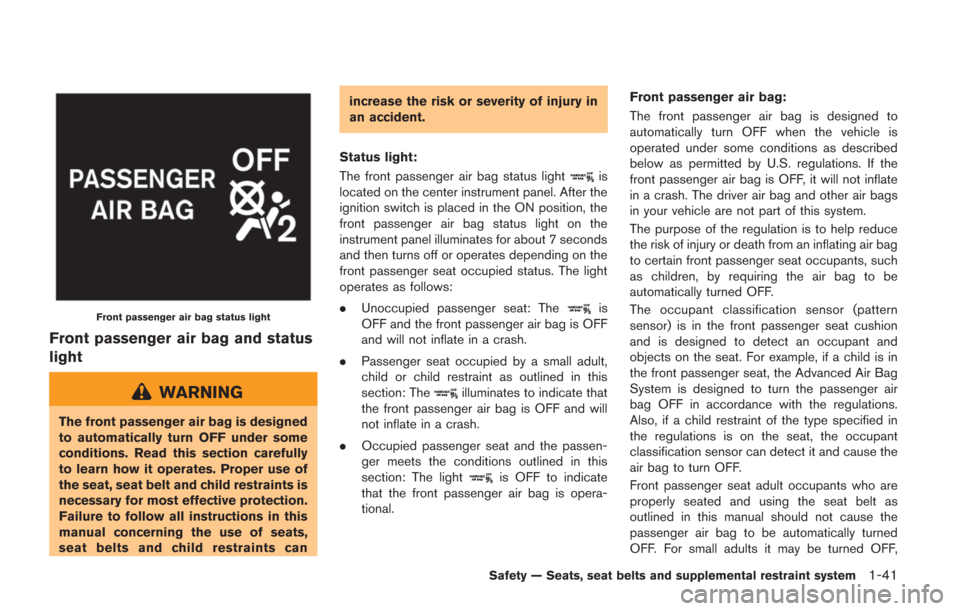
Front passenger air bag status light
Front passenger air bag and status
light
WARNING
The front passenger air bag is designed
to automatically turn OFF under some
conditions. Read this section carefully
to learn how it operates. Proper use of
the seat, seat belt and child restraints is
necessary for most effective protection.
Failure to follow all instructions in this
manual concerning the use of seats,
seat belts and child restraints canincrease the risk or severity of injury in
an accident.
Status light:
The front passenger air bag status light
is
located on the center instrument panel. After the
ignition switch is placed in the ON position, the
front passenger air bag status light on the
instrument panel illuminates for about 7 seconds
and then turns off or operates depending on the
front passenger seat occupied status. The light
operates as follows:
. Unoccupied passenger seat: The
is
OFF and the front passenger air bag is OFF
and will not inflate in a crash.
. Passenger seat occupied by a small adult,
child or child restraint as outlined in this
section: The
illuminates to indicate that
the front passenger air bag is OFF and will
not inflate in a crash.
. Occupied passenger seat and the passen-
ger meets the conditions outlined in this
section: The light
is OFF to indicate
that the front passenger air bag is opera-
tional. Front passenger air bag:
The front passenger air bag is designed to
automatically turn OFF when the vehicle is
operated under some conditions as described
below as permitted by U.S. regulations. If the
front passenger air bag is OFF, it will not inflate
in a crash. The driver air bag and other air bags
in your vehicle are not part of this system.
The purpose of the regulation is to help reduce
the risk of injury or death from an inflating air bag
to certain front passenger seat occupants, such
as children, by requiring the air bag to be
automatically turned OFF.
The occupant classification sensor (pattern
sensor) is in the front passenger seat cushion
and is designed to detect an occupant and
objects on the seat. For example, if a child is in
the front passenger seat, the Advanced Air Bag
System is designed to turn the passenger air
bag OFF in accordance with the regulations.
Also, if a child restraint of the type specified in
the regulations is on the seat, the occupant
classification sensor can detect it and cause the
air bag to turn OFF.
Front passenger seat adult occupants who are
properly seated and using the seat belt as
outlined in this manual should not cause the
passenger air bag to be automatically turned
OFF. For small adults it may be turned OFF,
Safety — Seats, seat belts and supplemental restraint system1-41
Page 91 of 354
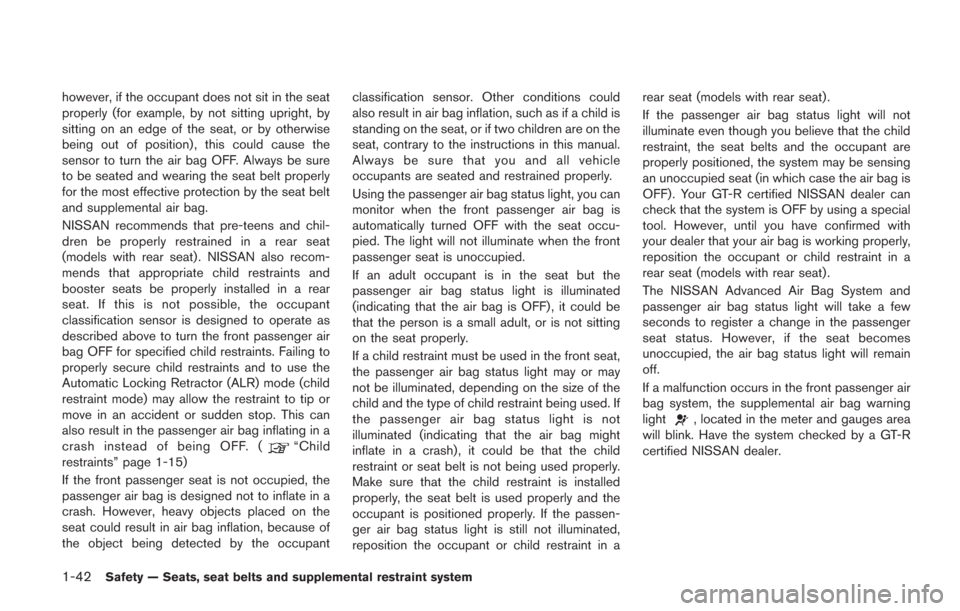
1-42Safety — Seats, seat belts and supplemental restraint system
however, if the occupant does not sit in the seat
properly (for example, by not sitting upright, by
sitting on an edge of the seat, or by otherwise
being out of position) , this could cause the
sensor to turn the air bag OFF. Always be sure
to be seated and wearing the seat belt properly
for the most effective protection by the seat belt
and supplemental air bag.
NISSAN recommends that pre-teens and chil-
dren be properly restrained in a rear seat
(models with rear seat) . NISSAN also recom-
mends that appropriate child restraints and
booster seats be properly installed in a rear
seat. If this is not possible, the occupant
classification sensor is designed to operate as
described above to turn the front passenger air
bag OFF for specified child restraints. Failing to
properly secure child restraints and to use the
Automatic Locking Retractor (ALR) mode (child
restraint mode) may allow the restraint to tip or
move in an accident or sudden stop. This can
also result in the passenger air bag inflating in a
crash instead of being OFF. (
“Child
restraints” page 1-15)
If the front passenger seat is not occupied, the
passenger air bag is designed not to inflate in a
crash. However, heavy objects placed on the
seat could result in air bag inflation, because of
the object being detected by the occupant classification sensor. Other conditions could
also result in air bag inflation, such as if a child is
standing on the seat, or if two children are on the
seat, contrary to the instructions in this manual.
Always be sure that you and all vehicle
occupants are seated and restrained properly.
Using the passenger air bag status light, you can
monitor when the front passenger air bag is
automatically turned OFF with the seat occu-
pied. The light will not illuminate when the front
passenger seat is unoccupied.
If an adult occupant is in the seat but the
passenger air bag status light is illuminated
(indicating that the air bag is OFF) , it could be
that the person is a small adult, or is not sitting
on the seat properly.
If a child restraint must be used in the front seat,
the passenger air bag status light may or may
not be illuminated, depending on the size of the
child and the type of child restraint being used. If
the passenger air bag status light is not
illuminated (indicating that the air bag might
inflate in a crash), it could be that the child
restraint or seat belt is not being used properly.
Make sure that the child restraint is installed
properly, the seat belt is used properly and the
occupant is positioned properly. If the passen-
ger air bag status light is still not illuminated,
reposition the occupant or child restraint in arear seat (models with rear seat) .
If the passenger air bag status light will not
illuminate even though you believe that the child
restraint, the seat belts and the occupant are
properly positioned, the system may be sensing
an unoccupied seat (in which case the air bag is
OFF). Your GT-R certified NISSAN dealer can
check that the system is OFF by using a special
tool. However, until you have confirmed with
your dealer that your air bag is working properly,
reposition the occupant or child restraint in a
rear seat (models with rear seat) .
The NISSAN Advanced Air Bag System and
passenger air bag status light will take a few
seconds to register a change in the passenger
seat status. However, if the seat becomes
unoccupied, the air bag status light will remain
off.
If a malfunction occurs in the front passenger air
bag system, the supplemental air bag warning
light
, located in the meter and gauges area
will blink. Have the system checked by a GT-R
certified NISSAN dealer.
Page 94 of 354
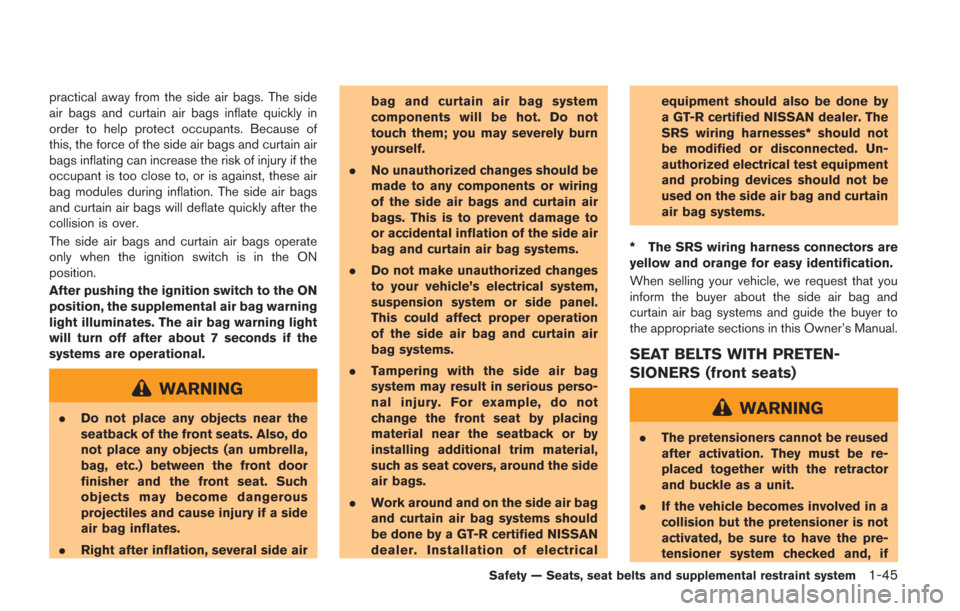
practical away from the side air bags. The side
air bags and curtain air bags inflate quickly in
order to help protect occupants. Because of
this, the force of the side air bags and curtain air
bags inflating can increase the risk of injury if the
occupant is too close to, or is against, these air
bag modules during inflation. The side air bags
and curtain air bags will deflate quickly after the
collision is over.
The side air bags and curtain air bags operate
only when the ignition switch is in the ON
position.
After pushing the ignition switch to the ON
position, the supplemental air bag warning
light illuminates. The air bag warning light
will turn off after about 7 seconds if the
systems are operational.
WARNING
.Do not place any objects near the
seatback of the front seats. Also, do
not place any objects (an umbrella,
bag, etc.) between the front door
finisher and the front seat. Such
objects may become dangerous
projectiles and cause injury if a side
air bag inflates.
. Right after inflation, several side air bag and curtain air bag system
components will be hot. Do not
touch them; you may severely burn
yourself.
. No unauthorized changes should be
made to any components or wiring
of the side air bags and curtain air
bags. This is to prevent damage to
or accidental inflation of the side air
bag and curtain air bag systems.
. Do not make unauthorized changes
to your vehicle’s electrical system,
suspension system or side panel.
This could affect proper operation
of the side air bag and curtain air
bag systems.
. Tampering with the side air bag
system may result in serious perso-
nal injury. For example, do not
change the front seat by placing
material near the seatback or by
installing additional trim material,
such as seat covers, around the side
air bags.
. Work around and on the side air bag
and curtain air bag systems should
be done by a GT-R certified NISSAN
dealer. Installation of electrical equipment should also be done by
a GT-R certified NISSAN dealer. The
SRS wiring harnesses* should not
be modified or disconnected. Un-
authorized electrical test equipment
and probing devices should not be
used on the side air bag and curtain
air bag systems.
* The SRS wiring harness connectors are
yellow and orange for easy identification.
When selling your vehicle, we request that you
inform the buyer about the side air bag and
curtain air bag systems and guide the buyer to
the appropriate sections in this Owner’s Manual.
SEAT BELTS WITH PRETEN-
SIONERS (front seats)
WARNING
. The pretensioners cannot be reused
after activation. They must be re-
placed together with the retractor
and buckle as a unit.
. If the vehicle becomes involved in a
collision but the pretensioner is not
activated, be sure to have the pre-
tensioner system checked and, if
Safety — Seats, seat belts and supplemental restraint system1-45
Page 95 of 354
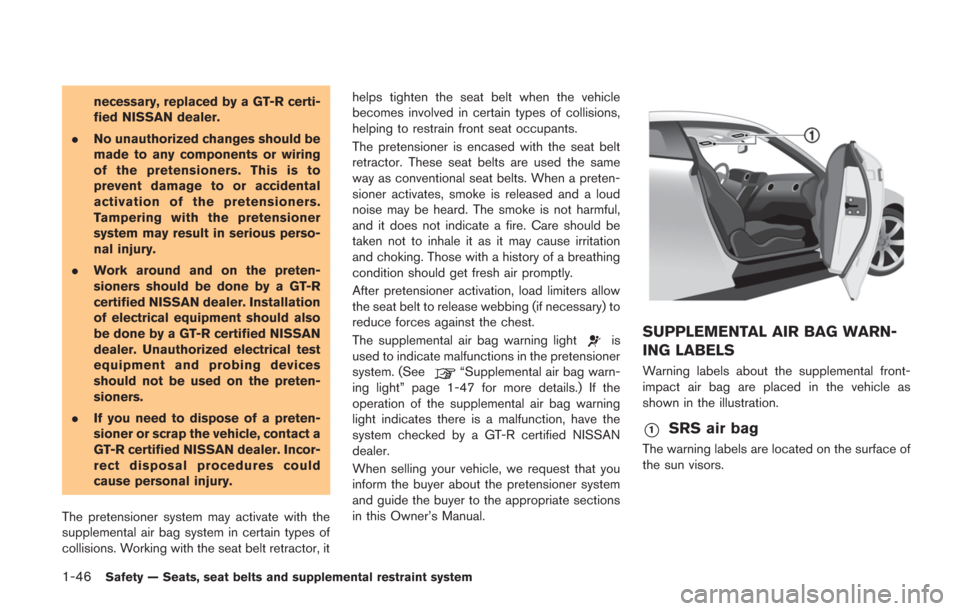
1-46Safety — Seats, seat belts and supplemental restraint system
necessary, replaced by a GT-R certi-
fied NISSAN dealer.
. No unauthorized changes should be
made to any components or wiring
of the pretensioners. This is to
prevent damage to or accidental
activation of the pretensioners.
Tampering with the pretensioner
system may result in serious perso-
nal injury.
. Work around and on the preten-
sioners should be done by a GT-R
certified NISSAN dealer. Installation
of electrical equipment should also
be done by a GT-R certified NISSAN
dealer. Unauthorized electrical test
equipment and probing devices
should not be used on the preten-
sioners.
. If you need to dispose of a preten-
sioner or scrap the vehicle, contact a
GT-R certified NISSAN dealer. Incor-
rect disposal procedures could
cause personal injury.
The pretensioner system may activate with the
supplemental air bag system in certain types of
collisions. Working with the seat belt retractor, it helps tighten the seat belt when the vehicle
becomes involved in certain types of collisions,
helping to restrain front seat occupants.
The pretensioner is encased with the seat belt
retractor. These seat belts are used the same
way as conventional seat belts. When a preten-
sioner activates, smoke is released and a loud
noise may be heard. The smoke is not harmful,
and it does not indicate a fire. Care should be
taken not to inhale it as it may cause irritation
and choking. Those with a history of a breathing
condition should get fresh air promptly.
After pretensioner activation, load limiters allow
the seat belt to release webbing (if necessary) to
reduce forces against the chest.
The supplemental air bag warning light
is
used to indicate malfunctions in the pretensioner
system. (See
“Supplemental air bag warn-
ing light” page 1-47 for more details.) If the
operation of the supplemental air bag warning
light indicates there is a malfunction, have the
system checked by a GT-R certified NISSAN
dealer.
When selling your vehicle, we request that you
inform the buyer about the pretensioner system
and guide the buyer to the appropriate sections
in this Owner’s Manual.
SUPPLEMENTAL AIR BAG WARN-
ING LABELS
Warning labels about the supplemental front-
impact air bag are placed in the vehicle as
shown in the illustration.
*1SRS air bag
The warning labels are located on the surface of
the sun visors.
Page 96 of 354
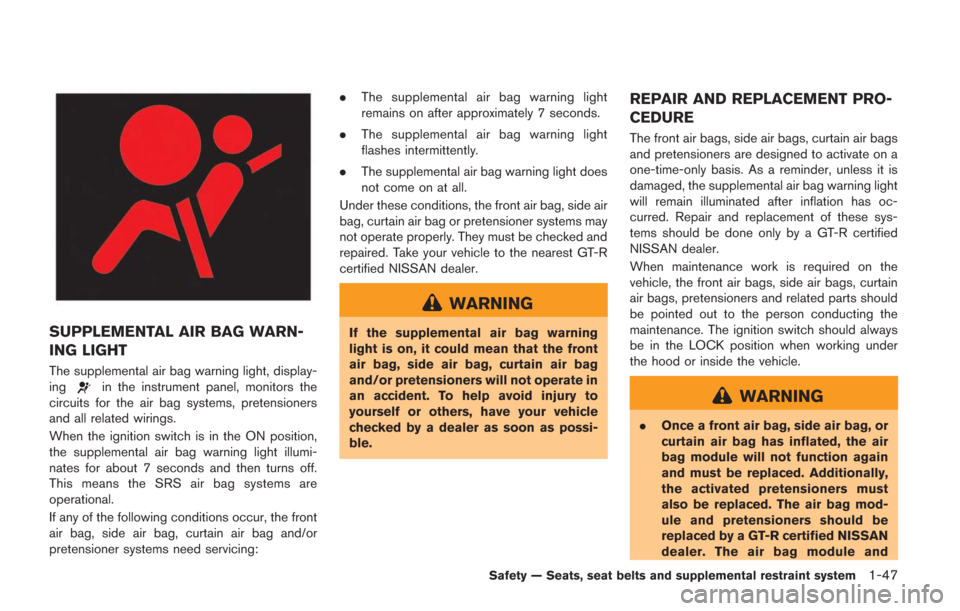
SUPPLEMENTAL AIR BAG WARN-
ING LIGHT
The supplemental air bag warning light, display-
ingin the instrument panel, monitors the
circuits for the air bag systems, pretensioners
and all related wirings.
When the ignition switch is in the ON position,
the supplemental air bag warning light illumi-
nates for about 7 seconds and then turns off.
This means the SRS air bag systems are
operational.
If any of the following conditions occur, the front
air bag, side air bag, curtain air bag and/or
pretensioner systems need servicing: .
The supplemental air bag warning light
remains on after approximately 7 seconds.
. The supplemental air bag warning light
flashes intermittently.
. The supplemental air bag warning light does
not come on at all.
Under these conditions, the front air bag, side air
bag, curtain air bag or pretensioner systems may
not operate properly. They must be checked and
repaired. Take your vehicle to the nearest GT-R
certified NISSAN dealer.
WARNING
If the supplemental air bag warning
light is on, it could mean that the front
air bag, side air bag, curtain air bag
and/or pretensioners will not operate in
an accident. To help avoid injury to
yourself or others, have your vehicle
checked by a dealer as soon as possi-
ble.
REPAIR AND REPLACEMENT PRO-
CEDURE
The front air bags, side air bags, curtain air bags
and pretensioners are designed to activate on a
one-time-only basis. As a reminder, unless it is
damaged, the supplemental air bag warning light
will remain illuminated after inflation has oc-
curred. Repair and replacement of these sys-
tems should be done only by a GT-R certified
NISSAN dealer.
When maintenance work is required on the
vehicle, the front air bags, side air bags, curtain
air bags, pretensioners and related parts should
be pointed out to the person conducting the
maintenance. The ignition switch should always
be in the LOCK position when working under
the hood or inside the vehicle.
WARNING
. Once a front air bag, side air bag, or
curtain air bag has inflated, the air
bag module will not function again
and must be replaced. Additionally,
the activated pretensioners must
also be replaced. The air bag mod-
ule and pretensioners should be
replaced by a GT-R certified NISSAN
dealer. The air bag module and
Safety — Seats, seat belts and supplemental restraint system1-47
Page 98 of 354
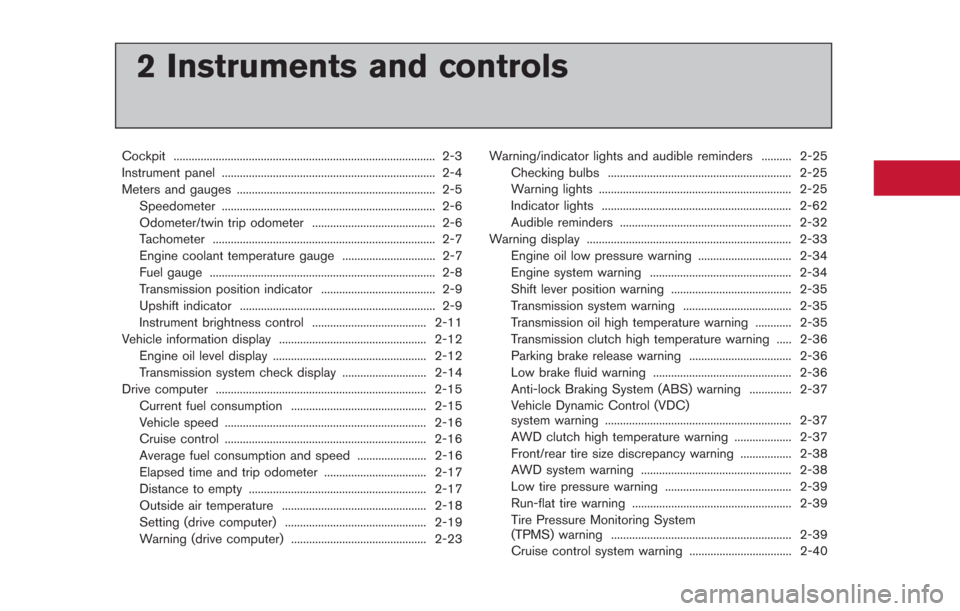
2 Instruments and controls
Cockpit ........................................................................\
............... 2-3
Instrument panel ....................................................................... 2-4
Meters and gauges .................................................................. 2-5Speedometer ....................................................................... 2-6
Odometer/twin trip odometer ......................................... 2-6
Tachometer ........................................................................\
.. 2-7
Engine coolant temperature gauge ............................... 2-7
Fuel gauge ........................................................................\
... 2-8
Transmission position indicator ...................................... 2-9
Upshift indicator ................................................................. 2-9
Instrument brightness control ...................................... 2-11
Vehicle information display ................................................. 2-12 Engine oil level display ................................................... 2-12
Transmission system check display ............................ 2-14
Drive computer ...................................................................... 2-15 Current fuel consumption ............................................. 2-15
Vehicle speed ................................................................... 2-16
Cruise control ................................................................... 2-16
Average fuel consumption and speed ....................... 2-16
Elapsed time and trip odometer .................................. 2-17
Distance to empty ........................................................... 2-17
Outside air temperature ................................................ 2-18
Setting (drive computer) ............................................... 2-19
Warning (drive computer) ............................................. 2-23 Warning/indicator lights and audible reminders .......... 2-25
Checking bulbs ............................................................. 2-25
Warning lights ................................................................ 2-25
Indicator lights ............................................................... 2-62
Audible reminders ......................................................... 2-32
Warning display .................................................................... 2-33
Engine oil low pressure warning ............................... 2-34
Engine system warning ............................................... 2-34
Shift lever position warning ........................................ 2-35
Transmission system warning .................................... 2-35
Transmission oil high temperature warning ............ 2-35
Transmission clutch high temperature warning ..... 2-36Parking brake release warning .................................. 2-36
Low brake fluid warning .............................................. 2-36
Anti-lock Braking System (ABS) warning .............. 2-37
Vehicle Dynamic Control (VDC)
system warning .............................................................. 2-37
AWD clutch high temperature warning ................... 2-37
Front/rear tire size discrepancy warning ................. 2-38
AWD system warning .................................................. 2-38
Low tire pressure warning .......................................... 2-39
Run-flat tire warning ..................................................... 2-39Tire Pressure Monitoring System
(TPMS) warning ............................................................ 2-39
Cruise control system warning .................................. 2-40
Page 99 of 354
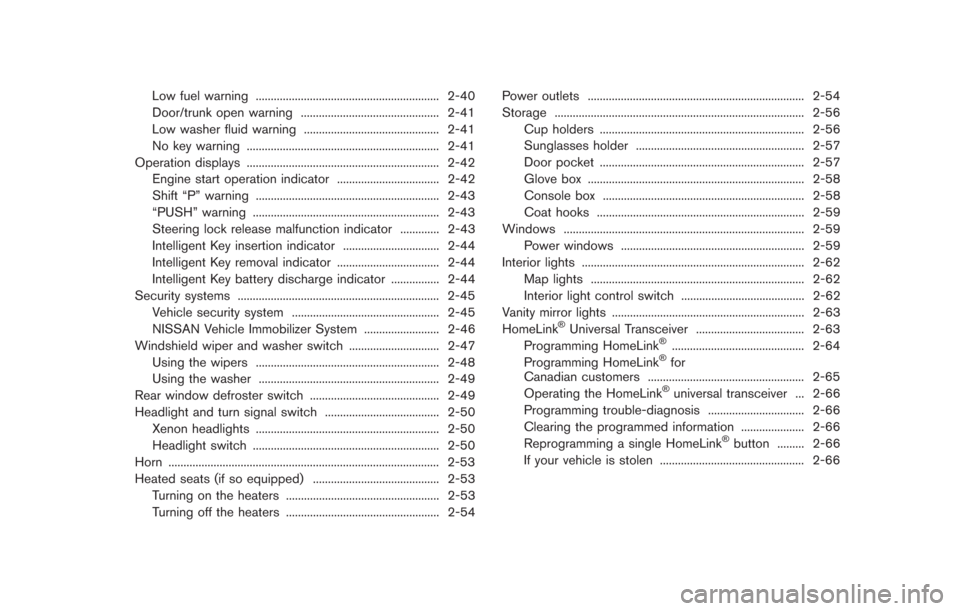
Low fuel warning ............................................................. 2-40
Door/trunk open warning .............................................. 2-41
Low washer fluid warning ............................................. 2-41
No key warning ................................................................ 2-41
Operation displays ................................................................ 2-42 Engine start operation indicator .................................. 2-42
Shift “P” warning ............................................................. 2-43
“PUSH” warning .............................................................. 2-43
Steering lock release malfunction indicator ............. 2-43
Intelligent Key insertion indicator ................................ 2-44
Intelligent Key removal indicator .................................. 2-44
Intelligent Key battery discharge indicator ................ 2-44
Security systems ................................................................... 2-45 Vehicle security system ................................................. 2-45
NISSAN Vehicle Immobilizer System ......................... 2-46
Windshield wiper and washer switch .............................. 2-47 Using the wipers ............................................................. 2-48
Using the washer ............................................................ 2-49
Rear window defroster switch ........................................... 2-49
Headlight and turn signal switch ...................................... 2-50 Xenon headlights ............................................................. 2-50
Headlight switch .............................................................. 2-50
Horn ........................................................................\
.................. 2-53
Heated seats (if so equipped) .......................................... 2-53
Turning on the heaters ................................................... 2-53Turning off the heaters ................................................... 2-54 Power outlets ........................................................................\
2-54
Storage ........................................................................\
........... 2-56
Cup holders .................................................................... 2-56
Sunglasses holder ........................................................ 2-57
Door pocket .................................................................... 2-57
Glove box ........................................................................\
2-58Console box ................................................................... 2-58
Coat hooks ..................................................................... 2-59
Windows ........................................................................\
........ 2-59 Power windows ............................................................. 2-59
Interior lights ........................................................................\
.. 2-62
Map lights ....................................................................... 2-62
Interior light control switch ......................................... 2-62
Vanity mirror lights ................................................................ 2-63
HomeLink
®Universal Transceiver .................................... 2-63
Programming HomeLink®............................................ 2-64
Programming HomeLink®for
Canadian customers .................................................... 2-65
Operating the HomeLink
®universal transceiver ... 2-66
Programming trouble-diagnosis ................................ 2-66
Clearing the programmed information ..................... 2-66
Reprogramming a single HomeLink
®button ......... 2-66
If your vehicle is stolen ................................................ 2-66
Page 101 of 354
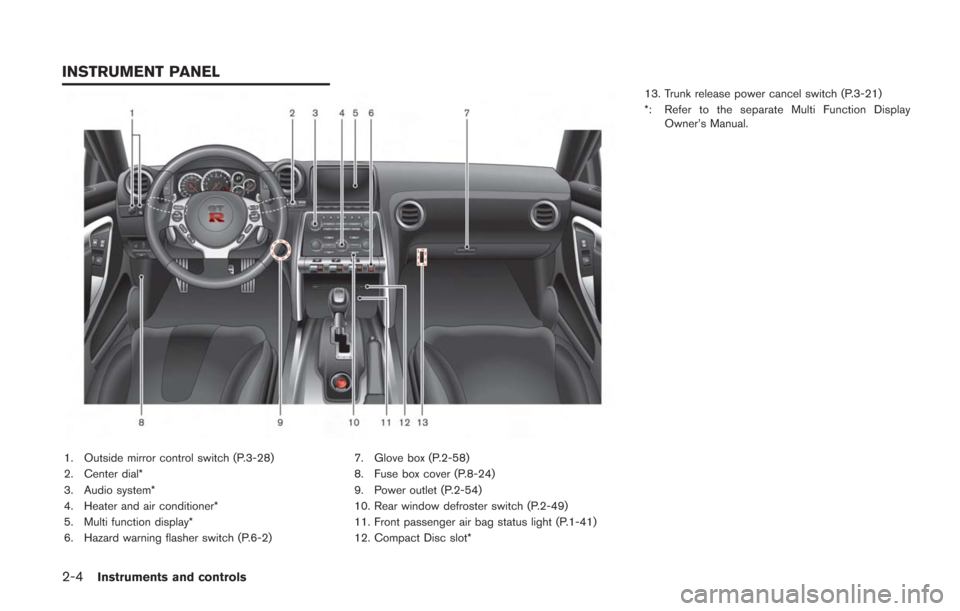
2-4Instruments and controls
1. Outside mirror control switch (P.3-28)
2. Center dial*
3. Audio system*
4. Heater and air conditioner*
5. Multi function display*
6. Hazard warning flasher switch (P.6-2)7. Glove box (P.2-58)
8. Fuse box cover (P.8-24)
9. Power outlet (P.2-54)
10. Rear window defroster switch (P.2-49)
11. Front passenger air bag status light (P.1-41)
12. Compact Disc slot*13. Trunk release power cancel switch (P.3-21)
*: Refer to the separate Multi Function Display
Owner’s Manual.
INSTRUMENT PANEL